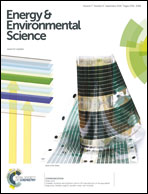3D printed flow plates for the electrolysis of water: an economic and adaptable approach to device manufacture
Abstract
The electrolysis of water is considered a promising route to the production of hydrogen from renewable energy sources. Electrolysers based on proton exchange membranes (PEMs) have a number of advantages including high current density, high product gas purity and the ability to operate at high pressure. Despite these advantages the high cost of such devices is an impediment to their widespread deployment. A principal factor in this cost are the materials and machining of flow plates for distribution of the liquid reagents and gaseous products in the electrochemical cell. We demonstrate the production and operation of a PEM electrolyser constructed from silver coated 3D printed components fabricated from polypropylene. This approach allows construction of light weight, low cost electrolysers and the rapid prototyping of flow field design. Furthermore we provide data on the operation of this electrolyser wherein we show that performance is excellent for a first generation device in terms of overall efficiency, internal resistances and current–voltage response. This development opens the door to the fabrication of light weight and cheap electrolysers as well as related electrochemical devices such as flow batteries and fuel cells.


 Please wait while we load your content...
Please wait while we load your content...